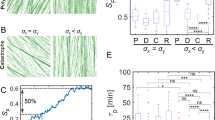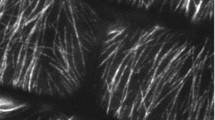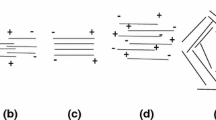Abstract
The organization of cortical microtubule arrays play an important role in the development of plant cells. Until recently, the direct mechanical influence of cell geometry on the constrained microtubule (MT) trajectories have been largely ignored in computational models. Modelling MTs as thin elastic rods constrained on a surface, a previous study examined the deflection of MTs using a fixed number of segments and uniform segment lengths between MT anchors. It is known that the resulting MT curves converge to geodesics as the anchor spacing approaches zero. In the case of long MTs on a cylinder, buckling has been found for transverse trajectories. There is a clear interplay between two factors in the problem of deflection: curvature of the membrane and the lengths of MT segments. Here, we examine the latter in detail, in the backdrop of a circular cylinder. In reality, the number of segments are not predetermined and their lengths are not uniform. We present a minimal, realistic model treating the anchor spacing as a stochastic process and examine the net effect on deflection. We find that, by tuning the ratio of growth speed to anchoring rate, it is possible to mitigate MT deflection and even prevent buckling for lengths significantly larger than the previously-derived critical buckling length. We suggest that this mediation of deflection by anchoring might provide cells with a means of preventing arrays from deflecting away from the transverse orientation.








Similar content being viewed by others
Data Availability
The Python code used to generate statistical data is available upon reasonable request.
References
Allard JF, Ambrose JC, Wasteneys GO et al (2010a) A mechanochemical model explains interactions between cortical microtubules in plants. Biophys J 99(4):1082–1090. https://doi.org/10.1016/j.bpj.2010.05.037
Allard JF, Wasteneys GO, Cytrynbaum EN (2010b) Mechanisms of self-organization of cortical microtubules in plants revealed by computational simulations. Mol Biol Cell 21(2):278–286. https://doi.org/10.1091/mbc.e09-07-0579
Ambrose JC, Wasteneys GO (2008) CLASP modulates microtubule-cortex interaction during self-organization of acentrosomal microtubules. Mol Biol Cell 19(11):4730–4737. https://doi.org/10.1091/mbc.e08-06-0665
Ambrose C, Allard JF, Cytrynbaum EN et al (2011) A clasp-modulated cell edge barrier mechanism drives cell-wide cortical microtubule organization in arabidopsis. Nat Commun. https://doi.org/10.1038/ncomms1444
Bachmann S, Froese R, Cytrynbaum EN (2019) A buckling instability and its influence on microtubule orientation in plant cells. SIAM J Appl Math 79(5):2132–2149. https://doi.org/10.1137/19M1264588
Baskin TI (2005) Anisotropic expansion of the plant cell wall. Annu Rev Cell Dev Biol 21(1):203–222. https://doi.org/10.1146/annurev.cellbio.20.082503.103053
Chakrabortty B, Blilou I, Scheres B et al (2018) A computational framework for cortical microtubule dynamics in realistically shaped plant cells. PLoS Comput Biol 14(2):1–26. https://doi.org/10.1371/journal.pcbi.1005959
Chan J, Sambade A, Calder G et al (2009) Arabidopsis cortical microtubules are initiated along, as well as branching from, existing microtubules. Plant Cell 21(8):2298–2306. https://doi.org/10.1105/tpc.109.069716
Colin L, Chevallier A, Tsugawa S et al (2020) Cortical tension overrides geometrical cues to orient microtubules in confined protoplasts. Proc Natl Acad Sci 117(51):32731–32738. https://doi.org/10.1073/pnas.2008895117
Deinum EE, Tindemans SH, Mulder BM (2011) Taking directions: The role of microtubule-bound nucleation in the self-organization of the plant cortical array. Phys Biol 8(5):056002. https://doi.org/10.1088/1478-3975/8/5/056002
Deinum EE, Tindemans SH, Lindeboom JJ et al (2017) How selective severing by katanin promotes order in the plant cortical microtubule array. Proc Natl Acad Sci 114(27):6942–6947. https://doi.org/10.1073/pnas.1702650114
Dixit R, Cyr R (2004) Encounters between dynamic cortical microtubules promote ordering of the cortical array through angle-dependent modifications of microtubule behavior. Plant Cell 16(12):3274–3284. https://doi.org/10.1105/tpc.104.026930
Eren EC, Dixit R, Gautam N (2010) A three-dimensional computer simulation model reveals the mechanisms for self-organization of plant cortical microtubules into oblique arrays. Mol Biol Cell 21(15):2674–2684. https://doi.org/10.1091/mbc.e10-02-0136
Eren EC, Gautam N, Dixit R (2012) Computer simulation and mathematical models of the noncentrosomal plant cortical microtubule cytoskeleton. Cytoskeleton 69(3):144–154. https://doi.org/10.1002/cm.21009
Halat L, Gyte K, Wasteneys G (2020) The microtubule-associated protein clasp is translationally regulated in light-dependent root apical meristem growth. Plant Physiol 184(4):2154–2167. https://doi.org/10.1104/pp.20.00474
Hamant O, Traas J (2010) The mechanics behind plant development. New Phytol 185(2):369–385. https://doi.org/10.1111/j.1469-8137.2009.03100.x
Hamant O, Inoue D, Bouchez D et al (2019) Are microtubules tension sensors? Nat Commun. https://doi.org/10.1038/s41467-019-10207-y
Hawkins RJ, Tindemans SH, Mulder BM (2010) Model for the orientational ordering of the plant microtubule cortical array. Phys Rev E. https://doi.org/10.1103/physreve.82.011911
Howard J (2001) Mechanics of motor proteins and the cytoskeleton. Sinauer Associates, Sunderland
Lagomarsino MC, Tanase C, Vos JW et al (2007) Microtubule organization in three-dimensional confined geometries: Evaluating the role of elasticity through a combined in vitro and modeling approach. Biophys J 92(3):1046–1057. https://doi.org/10.1529/biophysj.105.076893
Lindeboom JJ, Lioutas A, Deinum EE et al (2013) Cortical microtubule arrays are initiated from a nonrandom prepattern driven by atypical microtubule initiation. Plant Physiol 161(3):1189–1201. https://doi.org/10.1104/pp.112.204057
Lindeboom JJ, Nakamura M, Saltini M et al (2018) Clasp stabilization of plus ends created by severing promotes microtubule creation and reorientation. J Cell Biol 218(1):190–205. https://doi.org/10.1083/jcb.201805047
Manning GS (1987) The winding of a relaxed elastic line on a cylinder. Q Appl Math 45(4):809–815. https://doi.org/10.1090/qam/917029
Mirabet V, Krupinski P, Hamant O et al (2018) The self-organization of plant microtubules inside the cell volume yields their cortical localization, stable alignment, and sensitivity to external cues. PLoS Comput Biol 14(2):1–23. https://doi.org/10.1371/journal.pcbi.1006011
Mitchison T, Kirschner M (1984) Dynamic instability of microtubule growth. Nature 312(5991):237–242. https://doi.org/10.1038/312237a0
Murata T, Sonobe S, Baskin TI et al (2005) Microtubule-dependent microtubule nucleation based on recruitment of gamma-tubulin in higher plants. Nat Cell Biol 7(10):961–968. https://doi.org/10.1038/ncb1306
Nickerson H, Manning GS (1988) Intrinsic equations for a relaxed elastic line on an oriented surface. Geometriae Dedicata. https://doi.org/10.1007/bf00151344
Pressley A (2012) Elementary differential geometry. Springer, Berlin
Shaw SL, Kamyar R, Ehrhardt DW (2003) Sustained microtubule treadmilling in arabidopsis cortical arrays. Science 300(5626):1715–1718. https://doi.org/10.1126/science.1083529
Tindemans SH, Hawkins RJ, Mulder BM (2010) Survival of the aligned: ordering of the plant cortical microtubule array. Phys Rev Lett. https://doi.org/10.1103/physrevlett.104.058103
Tindemans S, Deinum E, Lindeboom J et al (2014) Efficient event-driven simulations shed new light on microtubule organization in the plant cortical array. Front Phys. https://doi.org/10.3389/fphy.2014.00019
Wightman R, Turner SR (2007) Severing at sites of microtubule crossover contributes to microtubule alignment in cortical arrays. Plant J 52(4):742–751. https://doi.org/10.1111/j.1365-313x.2007.03271.x
Xq S, Yq M (2010) Understanding phase behavior of plant cell cortex microtubule organization. Proc Natl Acad Sci 107(26):11709–11714. https://doi.org/10.1073/pnas.1007138107
Acknowledgements
This work was funded by the NSERC Discovery Grants of ENC and CBM.
Author information
Authors and Affiliations
Contributions
Conceptualization: Eric N. Cytrynbaum (ENC), Colin B. Macdonald (CBM), Tim Y.Y. Tian (TYYT); Methodology: TYYT; Formal analysis and investigation: TYYT; Writing - original draft preparation: TYYT; Writing - review and editing: ENC, CBM, TYYT; Funding acquisition: ENC, CBM; Supervision: ENC, CBM.
Corresponding author
Ethics declarations
Conflict of interest
The authors declare that there are no competing interests directly or indirectly related to this work.
Additional information
Publisher's Note
Springer Nature remains neutral with regard to jurisdictional claims in published maps and institutional affiliations.
Appendix A Steady State
Appendix A Steady State
Numerical confirmation of the steady state tip length approximation (A5), as a function of small values of \(l_d\). Starting with \(l_0=0\), 1000 trials were simulated with 40 anchoring steps each. The steady state tip length \(l^*\) is found by averaging the final tip lengths of the 1000 trials (dotted). The approximate \(l^*\) was found by numerically solving (A5) for \(l^*\)
The two-step process can be reduced to a single step, with the Markov kernel \(K(l|l^n)\) describing the probability density of having tip length l given \(l^n\) previously. The subscript “\(_\text {tip}\)” will be dropped for these variables. To find K, we first find the density describing anchoring at point \(l_0^{n+1}\in [0,l^n]\), \(\psi (l_0^{n+1}|l^n)\). This is uniform. Then we condition the probability of growing to length l given initial \(l_0^{n+1}\), \(P(l|l_0^{n+1})\), to get \(K(l|l_0^{n+1}|l^n)=P(l|l_0^{n+1})\psi (l_0^{n+1}|l^n)\). Integrating over the intermediate variable denoted as \(l_0\) rather than \(l_0^{n+1}\),
Suppose there exists a stationary distribution \(K_s(l)\). Then, given that this has been reached, the next step will have this same distribution. This is given by the Fredholm integral equation
This cannot be solved analytically. Rather, we make a closure approximation that the stationary distribution is approximated by the distribution given by having length \(l^*\) in the previous step,
Heuristically, this is true if the stationary distribution is sharply peaked around \(l^*\). In such case, the previous step, having reached steady state, will sample from \(K_s(l)\) and return values near \(l^*\). Indeed, in the limit \(K_s(l) = \delta (l-l^*)\),
Then one is able to solve for \(l^*\) with the relation
This is confirmed to be accurate numerically in Fig. 9 for small values of \(l_d\). Larger values of \(l_d\) requires more a careful implementation of the numerical root-solving for Eq. (A5), not attempted here. One notes that as \(l_d\) increases, the approximation worsens. This is expected because, as \(l_d\) increases, the tip length distribution widens, diverging from the delta-function distribution limit.
Rights and permissions
Springer Nature or its licensor (e.g. a society or other partner) holds exclusive rights to this article under a publishing agreement with the author(s) or other rightsholder(s); author self-archiving of the accepted manuscript version of this article is solely governed by the terms of such publishing agreement and applicable law.
About this article
Cite this article
Tian, T.Y.Y., Macdonald, C.B. & Cytrynbaum, E.N. A Stochastic Model of Cortical Microtubule Anchoring and Mechanics Provides Regulatory Control of Microtubule Shape. Bull Math Biol 85, 103 (2023). https://doi.org/10.1007/s11538-023-01211-x
Received:
Accepted:
Published:
DOI: https://doi.org/10.1007/s11538-023-01211-x





